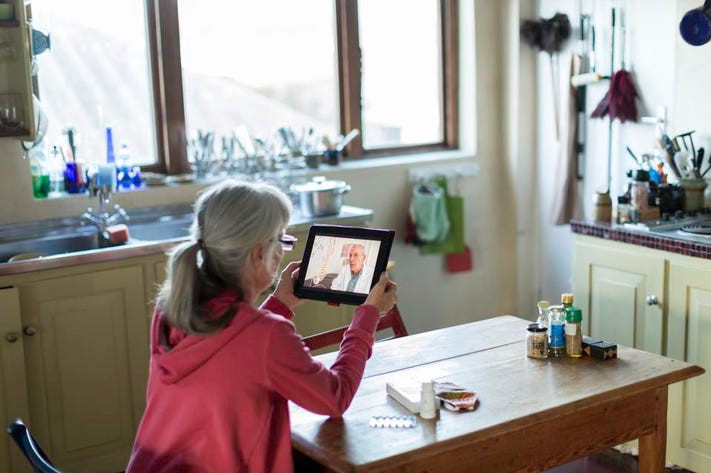Healthcare Comes Back Home
Forbes Technology Council
A.J. Ghergich
Feb 11, 2022
Introduction
When we face a serious health issue that demands attention, we typically access that care beyond the confines of our home, traveling to a healthcare facility like a doctor’s office, urgent care clinic or — in especially serious situations — the hospital.
Back To The Future
It hasn’t always been that way. Healthcare — from birth through death — once happened in the home.
Now, with a boost from technology, we may find that home once again provides more and more of our healthcare solutions.
How did we get to this place? In the Middle Ages, barbers, skilled in wielding sharp instruments like razors and scissors, diversified into a range of procedures aimed at restorative health. They practiced bloodletting and tooth-pulling, as well as surgical procedures such as bladder-stone removal and limb amputation.
War: What Is it Good For?
Many barber-surgeons worked from shops or storefronts with red, white and blue poles. Meanwhile, “ flying barbers” took their services from town to town either in the home or on the battlefield.
They were the predecessor of house-call doctors or Mobile Army Surgical Hospital (MASH) units.
Hospitals Interrupted
War is a scourge, but it’s also a profound change accelerant — especially with respect to medicine and healthcare.
During the U.S. Civil War, thousands of wounded and sick soldiers prompted a proportionate medical response. Armies needed beds, bandages and surgeries at scale.
The response became a giant leap forward for medical practice. Public expectations shifted, and new practices migrated from the military to the civilian sphere.
Hospitals evolved and soon became a fixture in our national and global healthcare system.
How permanent is the hospital’s position in modern life?
In an interview with the New York Times, George Halvorson, the former CEO of Kaiser Permanente, challenged us to look beyond hospitals for better solutions to healthcare problems by “[moving] care farther and farther from the hospital setting — and even out of doctors’ offices.”
The data support this shift.
- Hospital admissions were trending downward across all age cohorts. The length of hospital stays is shrinking for procedures like childbirth, joint replacement and cardiac surgery.
- In-patient services at hospitals are expensive, straining the budgets of households, employers and national economies.
The average daily charge for a hospital bed is several thousand dollars.
Patients can get treatments and procedures in doctors’ offices and ambulatory surgical centers for much less. - Hospital stays can be risky.
Hospital-acquired infections and medical errors are two preventable causes of death in hospitals.
While precise estimates have been subject to considerable debate, estimates of preventable hospital deaths range from as many as 100,000 to well over two times that number.
While the debate continues, there is risk involved.
Smart Home Equals Smart Healthcare
4. Better and cheaper alternatives to hospital care exist.
A “ continuum of care” supports those who need medical attention.
That continuum moves from home care to residential care to acute care.
Each has its role, but home healthcare typically combines the lowest cost of care with the highest quality of life.
The pendulum is swinging back home.
Whereas technology once pulled many breakthrough innovations beyond the home, it’s now enabling a virtual homecoming for those same activities. Home offices, remote classrooms and home gyms are commonplace. Hardware and software advances have been combined with ingenious design and artificial intelligence to inspire its own category: the smart home.
Many smart devices have home-healthcare applications.
Amazon recently announced a new service called “Alexa Together” that targets families with aging family members who live independently and may require extra monitoring, support and emergency services.
Smartwatches can detect falls and summon quick assistance.
Of course, the smartphone can monitor an impressive range of human activity, access relevant data, find information and tap expertise.
Phones can also administer care through meditation apps, weight-loss programs and behavioral nudges.
In an NPR interview, Dr. Eric Topol reports that a UCLA startup may even coax our smartphones to take X-rays — the ultimate selfie.
In an NPR interview, Dr. Eric Topol reports that a UCLA startup may even coax our smartphones to take X-rays — the ultimate selfie.
How Will The Healthcare Establishment Respond?
More technological advancements are coming.
Advances in virtual reality platforms could allow virtual doctor visits and consultations.
Plus, they may enable experiences that mimic travel, entertainment and social interaction to reduce social isolation and boost mental health.
The prospect of more healthcare delivered in a home setting represents a big shift in the industry.
Control and power are shifting away from the medical establishment and toward the consumer of healthcare — a seismic change in the established paradigm.
The patient increasingly will call the shots. How will the traditional healthcare establishments and professionals respond?
Control and power are shifting away from the medical establishment and toward the consumer of healthcare — a seismic change in the established paradigm.
The stakes are high. Not only do patients expect better treatment and outcomes — at costs that are both transparent and affordable — but the size and inefficiencies of our healthcare system encourage competition from outside the system.
Newcomers and tech firms that have demonstrated the potential of data-driven service models can apply their business models and platforms to get a piece of a multitrillion-dollar healthcare market that looks ripe for disruption.
The battle lines are forming. The winners will break through in these areas.
1. Utilization of personal health data. With the spread of activity monitors and the continuous capture of information about sleep, heart rate, blood sugar and more, the scale and scope of personal health data has jumped ahead of healthcare providers’ capacity to manage, analyze and use it. Electronic health records (EHRs) have now arrived, but patients have yet to see all the expected and promised benefits.
2. Better patient experience. For too long, dealing with the healthcare establishment has been a frustratingly slow and complex experience for patients. While other industries have harnessed digital services to streamline shopping, payment, delivery and consumption, traditional healthcare providers continue to lag.
3. Home sweet home. The continuum of care is shifting from institutional settings — the hospital in particular — to more convenient locations for patients. Home care puts less of a cost burden on resource-constrained consumers. Meanwhile, patients can enjoy the therapeutic comforts of their familiar surroundings. Who will be the first to hang out the “Welcome Home” sign?
About the author
President and CTO of Brado, overseeing the company’s digital marketing, data science and NLP technology.
Originally published at https://www.forbes.com.
Table of Contents
Introduction
- Back To The Future
- War: What Is it Good For?
- Hospitals Interrupted
- The data support this shift.
- Smart Home Equals Smart Healthcare
How Will The Healthcare Establishment Respond?
- The battle lines are forming.
- The winners will break through in these areas:
1.Utilization of personal health data;
2. Better patient experience
3. Home sweet home












